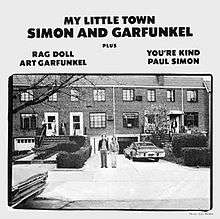My Little Town
| "My Little Town" | ||||
|---|---|---|---|---|
 | ||||
| Single by Simon & Garfunkel | ||||
| from the album Still Crazy After All These Years Breakaway | ||||
| B-side |
"Rag Doll" (Art Garfunkel) "You're Kind" (Paul Simon) | |||
| Released | October 1975 | |||
| Format | 7" single | |||
| Genre | Rock, pop | |||
| Length | 3:51 | |||
| Label | Columbia | |||
| Writer(s) | Paul Simon | |||
| Producer(s) |
| |||
| Simon & Garfunkel singles chronology | ||||
| ||||
"My Little Town" is a 1975 song by the American duo Simon & Garfunkel. It was written by Paul Simon, who produced the track along with Art Garfunkel and Phil Ramone. Although the song would not appear on any of the duo's albums until later, it was included on both the solo releases for Simon (Still Crazy After All These Years) and Garfunkel (Breakaway) in 1975. This song was the first new single for Simon & Garfunkel since 1972's single hit "America". It became an all-new Simon & Garfunkel reunion single.
History
In 1970 Simon and Garfunkel decided to part ways and record their own solo material.
In June 1972 they were asked to sing at a political benefit concert for United States presidential candidate George McGovern at Madison Square Garden, New York City.[1]
By 1975 Simon had decided to prepare material for a new solo album. The music was a bit more personal, but one song was written in particular with Garfunkel specifically in mind. He has been quoted as saying: "It originally was a song I was writing for Artie. I was gonna write a song for his new album, and I told him it would be a nasty song, because he was singing too many sweet songs. It seemed like a good concept for him."[2] After playing the song for Garfunkel, the two decided to collaborate again in the studio on this one track.
Simon has stated that the song is not autobiographical; instead he says that it is about "someone who hates the town he grew up in. Somebody happy to get out."[2]
Garfunkel has explained that the song was about his own childhood, how he "grew up in an area where a career in music was not seen as either desirable nor exciting". Garfunkel's parents insisted he gain some qualification aside from his singing (he earned a bachelor's degree in art history in 1965, and a master's degree in mathematics in 1967). Garfunkel, upon the break-up of the duo, worked as a teacher in Connecticut, a draftsman in New York and a math tutor in Los Angeles, before working on a solo album himself, coincidentally, at the same time as Simon.
The song references the lines of a Ted Hughes poem (quoted in liner notes to Paul Simon's release of the song: "To hatch a crow, a black rainbow/Bent in emptiness/over emptiness/But flying"), the song relates the town's sameness suggesting even the colors of the rainbow there are black. The final verse describes the narrator feeling like "just my father's son...twitching like a finger on the trigger of a gun/leaving nothing but the dead and dying back in my little town".
The song starts off very quietly, beginning with a piano solo (by Barry Beckett) and light drum work from Roger Hawkins. They begin to sing together (there are no solo parts), with Paul Simon providing acoustic guitar, Pete Carr playing electric guitar, a subdued bassline courtesy of David Hood and percussion courtesy of Ralph MacDonald. The choruses of "nothin' but the dead and dyin' back in my little town" are played with an increased intensity, especially the final repeat-and-fadeout section following the last verse, with some horns and backing vocals added to the mix.
On October 18, 1975, Simon hosted the second episode of the premiere season of the NBC comedy sketch program Saturday Night Live. During the musical numbers, Garfunkel performed with him, and together they sang three songs: "The Boxer"; "Scarborough Fair", and their new collaboration, simply titled "My Little Town".[3]
Charts
The buzz surrounding the surprise reunion of the two singers helped to generate anticipation for each of their solo albums, which were released within a few weeks of the performance on Saturday Night Live. Credited on both albums as being performed by 'Simon & Garfunkel', "My Little Town" became the duo's eighth top-ten hit on the Billboard Hot 100 chart in late 1975, peaking at number nine.[4] It spent two weeks atop the Billboard adult contemporary chart, and was their second number one on this survey as a duo.[2] Both singers have hit number one on the adult contemporary chart as solo performers as well, Garfunkel four times and Simon twice.
Chart performance
Weekly charts
|
Year-end charts
|
See also
References
- ↑
- 1 2 3 Hyatt, Wesley (1999). The Billboard Book of Number One Adult Contemporary Hits (Billboard Publications)
- ↑ "History - Guests by Season". Saturday-Night-Live.com. Retrieved 2016-10-10.
- ↑ Whitburn, Joel (2004). The Billboard Book of Top Forty Hits, 8th Edition (Billboard Publications)
- ↑ "Image : RPM Weekly - Library and Archives Canada". Bac-lac.gc.ca. Retrieved 2016-10-10.
- ↑ "Image : RPM Weekly - Library and Archives Canada". Bac-lac.gc.ca. Retrieved 2016-10-10.
- ↑ Steffen Hung. "Simon And Garfunkel - My Little Town". Swisscharts.com. Retrieved 2016-10-10.
- ↑ "NZ Top 40 Singles Chart | The Official New Zealand Music Chart". Nztop40.co.nz. 1976-02-09. Retrieved 2016-10-10.
- ↑ Salaverri, Fernando (September 2005). Sólo éxitos: año a año, 1959–2002 (1st ed.). Spain: Fundación Autor-SGAE. ISBN 84-8048-639-2.
- ↑ [Joel Whitburn's Top Pop Singles 1955-2002]
- ↑ [Joel Whitburn's Top Pop Singles 1955-2002]
- ↑ "Cash Box Top 100 12/13/75". Tropicalglen.com. 1975-12-13. Retrieved 2016-10-10.
- ↑ "Image : RPM Weekly - Library and Archives Canada". Bac-lac.gc.ca. Retrieved 2016-10-10.
- ↑ Whitburn, Joel (1999). Pop Annual. Menomonee Falls, Wisconsin: Record Research Inc. ISBN 0-89820-142-X.